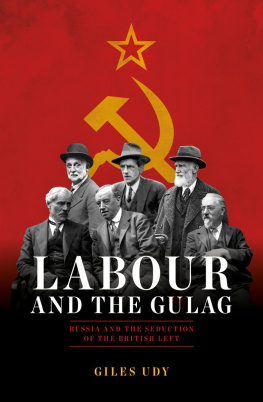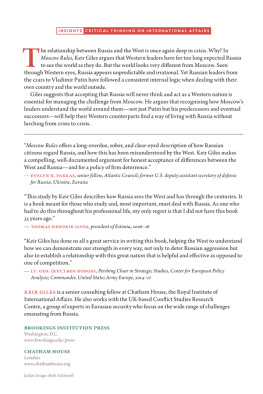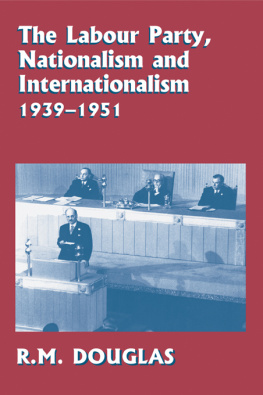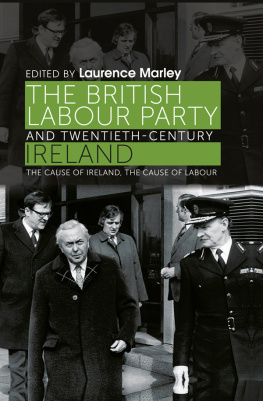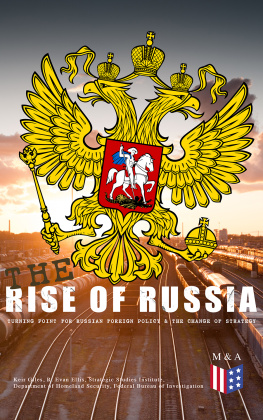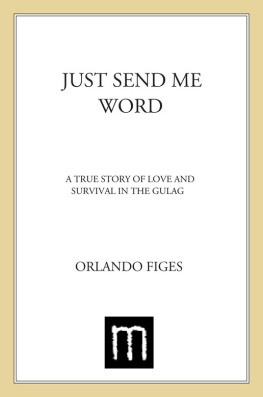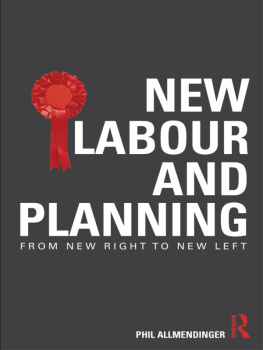Giles Udy - Labour and the Gulag: Russia and the Seduction of the British Left
Here you can read online Giles Udy - Labour and the Gulag: Russia and the Seduction of the British Left full text of the book (entire story) in english for free. Download pdf and epub, get meaning, cover and reviews about this ebook. year: 2017, publisher: Biteback Publishing, genre: Politics. Description of the work, (preface) as well as reviews are available. Best literature library LitArk.com created for fans of good reading and offers a wide selection of genres:
Romance novel
Science fiction
Adventure
Detective
Science
History
Home and family
Prose
Art
Politics
Computer
Non-fiction
Religion
Business
Children
Humor
Choose a favorite category and find really read worthwhile books. Enjoy immersion in the world of imagination, feel the emotions of the characters or learn something new for yourself, make an fascinating discovery.
Labour and the Gulag: Russia and the Seduction of the British Left: summary, description and annotation
We offer to read an annotation, description, summary or preface (depends on what the author of the book "Labour and the Gulag: Russia and the Seduction of the British Left" wrote himself). If you haven't found the necessary information about the book — write in the comments, we will try to find it.
Giles Udy: author's other books
Who wrote Labour and the Gulag: Russia and the Seduction of the British Left? Find out the surname, the name of the author of the book and a list of all author's works by series.
Labour and the Gulag: Russia and the Seduction of the British Left — read online for free the complete book (whole text) full work
Below is the text of the book, divided by pages. System saving the place of the last page read, allows you to conveniently read the book "Labour and the Gulag: Russia and the Seduction of the British Left" online for free, without having to search again every time where you left off. Put a bookmark, and you can go to the page where you finished reading at any time.
Font size:
Interval:
Bookmark:

T his book began ten years ago as one that was very different. I was researching the history of the labour camps in Norilsk, a city so high in the Siberian Arctic that it experiences six weeks of total darkness each winter and temperatures that fall as low as -50C (-58F). It is so isolated that the nearest road system is 800 miles south and the only way in for the prisoners was a 1,200-mile journey north on the river Yenisei in the summer months when the river was not icebound. Because of the rich mineral wealth that lies deep beneath its permafrost, the city began life as one of the most notorious of the Stalin-era gulag camps. It was a prison city. My intention was to tell the back-story of the 300,000 prisoners who passed through the camps, and the different nations and groups from which they came, each with its own testimony of suffering and oppression.
Many of the first Norilsk prisoners had been transferred from the White Sea labour camps on the Solovetsky Islands in anticipation of the outbreak of the war. Solovki, as they were collectively known, was the prototype Soviet concentration camp group. Solzhenitsyn likened it to the original cancer tumour which metastasised to become the Gulag Archipelago, the title of his famous trilogy.
The White Sea regions only resource was timber, which, I discovered, was imported into Britain in vast quantities in the early 1930s. In 1930, the total value was over 9 million, equivalent to more than 530 million today, and it amounted to well over a million tons each year. It was cut by hundreds of thousands of gulag slave labourers, working in terrible conditions, and as a consequence, an extraordinary campaign arose to persuade the British Labour government to halt the trade and protest to the Soviets about the slave labour that generated it. To my astonishment, I found that Labour had persistently refused to do so and had even blocked attempts to launch an inquiry into the conditions in the camps.
I assumed that other historians would have noticed these events and written about them. I was surprised to find that no such writings existed. With the exception of passing mentions of just a few pages in one or two other works on the period, at least one of which was full of mistakes, there was nothing. This was a totally new, untold story. It had to be written. My original project was put to one side, to be taken up at another time, and the result is this book.
Because of my background in gulag research I came to this part of British political history from a completely different direction to those of most other historians of the period. I am not, and do not pretend to be, a historian of the Labour Party or of British Communism, unlike the academics who form the vast majority of those who have written about British inter-war politics. Instead I came with an intimate knowledge, gleaned from countless prisoner memoirs, of the actual experience of those who suffered under Soviet oppression.
I knew what really happened to those hundreds of thousands in Russia whose plight so many in the British Labour movement had casually dismissed. I had followed the route on which some of those early prisoners were taken, sailing for almost a thousand miles on one of the last river ferries going north before the winter freeze set in. I had seen for myself the vast expanse of the Siberian wilderness, and as my ferry had moored at small riverside villages along the way, I knew the stories of those who were sent as exiles to those villages, those who, even though they had escaped the fate of the prisoners sent to the camps further north, had still experienced devastating trauma. Many did not survive to return to their homes in the post-Stalin thaw. Little physical evidence remains of their stories, but in Norilsk, where the permafrost is like concrete and graves dug by weakened inmates were sometimes sunk too shallow, seasonal ground movement still brings bones to the surface. Others lie deeper, their remains mummified beneath the ice. Tens of thousands died in Norilsk alone.
I had stood in a gulag punishment block, the inner prison of a punishment camp to which prisoners from normal labour camps were sentenced, sometimes for the most minor of infringements. It was the very worst of the worst and only by some miracle it was still standing; even today the authorities prefer such things not to be known. I had seen the refinement of cruelty with which the cells had been designed: the dark isolation cell, scarcely longer than a mans height, sealed with double doors and no window, so neither light nor sound would penetrate; open cells with no roof, where prisoners were exposed to the elements and in the Arctic winter would quickly succumb. The metal sheet which lined the inside of these cell doors was studded all over with multiple piercings, a grim addition which meant that those who, in their final despair, tried to bang on the doors to be let out, would only shred their hands. I had seen what became of the gulag system in this, its pinnacle, even though eminent British Labour figures had praised Russian prisons as being more humane than our own and turned a blind eye to appeals on behalf of the thousands who were consigned to them.
I had walked in Bykivnia Forest just outside Kiev, in Ukraine, among trees planted by the NKVD, the Peoples Commissariat of Internal Affairs, to hide the mass graves of over 100,000 of its victims. Kept secret until the fall of Communism, the forest now holds a sacred place in Ukrainian national memory. Just one of many sites that form the Soviet killing fields some known, others still to be found Bykivnia keeps alive the story of suffering, even as the photos of the dead, pinned to trees by surviving relatives, begin to fade. And yet, in the 1920s, George Bernard Shaw, less known today than he was then as one of Labours most charismatic public speakers, commended the Soviet executions that filled mass graves such as these as a necessary weeding of the garden.
In spite of all this, I have tried to remain as objective as possible, though at times that has been hard. To those readers who feel that my passion still intrudes too much, I apologise. Eighty years ago a large proportion of Britains political intelligentsia closed their ears to appeals on behalf of these people. Those appeals still demand a hearing.
The structure of the book follows a chronological pattern but still needs some explanation. It became apparent in dealing with the events of 192931 that they could not be discussed without regard for the earlier context from which they arose. Additionally, they provoke many questions. How could all of this have come about? What was the emotional connection between British inter-war Socialism and communist Russia? For that matter, what was Labour Socialism in those days? What was Communism? Were the excesses of Soviet Communism the product of Stalins later corruption of Lenin, or were they present from the start, for all those who were prepared to look, to see?
From a willingness to give the benefit of the doubt to the British political movement which sprang from compassion for the poor and the marginalised, further specific questions arise: Was Labours apparent callousness an aberration? Did Labours Soviet enthusiasts form only a minority of the party, an extreme fringe? Perhaps there really was so little information available that they could not have known what was happening in Russia. Was this why they were so silent? If they did not respond when appeals were made on behalf of those in the camps, when did they wake up to what was going on in Soviet Russia? What did they do then?
Font size:
Interval:
Bookmark:
Similar books «Labour and the Gulag: Russia and the Seduction of the British Left»
Look at similar books to Labour and the Gulag: Russia and the Seduction of the British Left. We have selected literature similar in name and meaning in the hope of providing readers with more options to find new, interesting, not yet read works.
Discussion, reviews of the book Labour and the Gulag: Russia and the Seduction of the British Left and just readers' own opinions. Leave your comments, write what you think about the work, its meaning or the main characters. Specify what exactly you liked and what you didn't like, and why you think so.

